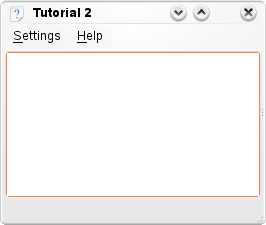Development/Tutorials/Using KXmlGuiWindow (pt BR): Difference between revisions
(New page: {{Template:I18n/Language Navigation Bar|Development/Tutorials/Using_KXmlGuiWindow}} {{TutorialBrowser| series=Beginner Tutorial| name=Como usar o KXmlGuiWindow| pre=[[Development/Tutori...) |
No edit summary |
||
| Line 47: | Line 47: | ||
First we Subclass KXmlGuiWindow on line 7 with <tt>class MainWindow : public KXmlGuiWindow</tt>. | First we Subclass KXmlGuiWindow on line 7 with <tt>class MainWindow : public KXmlGuiWindow</tt>. | ||
Então nós declaramos o construtor com <tt>MainWindow(QWidget *parent=0);</tt>. | |||
And finally we declare a pointer to the object that will make up the bulk of our program. {{class|KTextEdit}} is a generic richtext editor with some KDE niceties like cursor auto-hiding. | And finally we declare a pointer to the object that will make up the bulk of our program. {{class|KTextEdit}} is a generic richtext editor with some KDE niceties like cursor auto-hiding. | ||
| Line 62: | Line 62: | ||
} | } | ||
</code> | </code> | ||
Primeiro, é claro, na linha 1 nós temos que incluir o arquivo de cabeçalho contendo a declaração da classe. | |||
On line 5, we initialise our text editor with an object. Then on line 6 we use KXmlGuiWindow's built-in setCentralWidget() function which tells the KXmlGuiWindow what should appear in the central section of the window. | On line 5, we initialise our text editor with an object. Then on line 6 we use KXmlGuiWindow's built-in setCentralWidget() function which tells the KXmlGuiWindow what should appear in the central section of the window. | ||
Finalmente, KXmlGuiWindow::setupGUI() é chamado, a qual faz várias coisas por-trás-dos-bastidores e cria a barra de menu padrão (Configurações, Ajuda). | |||
==Back to main.cpp== | ==Back to main.cpp== | ||
| Line 95: | Line 95: | ||
} | } | ||
</code> | </code> | ||
As únicas linhas novas aqui (comparadas com o Tutorial 1) são 5, 18 e 19. Na linha 18, nós criamos o nosso objeto MainWindow e então, na linha 19, nós a exibimos. | |||
==CMake== | ==CMake== | ||
Revision as of 20:24, 27 November 2008
Development/Tutorials/Using_KXmlGuiWindow
Languages: عربي | Asturianu | Català | Česky | Kaszëbsczi | Dansk | Deutsch | English | Esperanto | Español | Eesti | فارسی | Suomi | Français | Galego | Italiano | 日本語 | 한국어 | Norwegian | Polski | Português Brasileiro | Română | Русский | Svenska | Slovenčina | Slovenščina | српски | Türkçe | Tiếng Việt | Українська | 简体中文 | 繁體中文
| Tutorial Series | Beginner Tutorial |
| Previous | Tutorial 1 - Hello World |
| What's Next | Tutorial 3 - KActions e XMLGUI |
| Further Reading | KXmlGuiWindow |
Resumo
This tutorial carries on from First Program Tutorial and will introduce the KXmlGuiWindow class.
No tutorial anterior, o programa criava uma caixa de diálogo pop up, mas nós agora iremos andar alguns passos em direção ao funcionamento de uma aplicação.

KXmlGuiWindow
KXmlGuiWindow fornece a visão de uma janela principal inteira com barra de menus, barra de ferramentas, uma barra de status e uma área no centro para um widget grande. Muitas aplicações KDE derivam desta classe já que ela fornece um jeito fácil de definir o layout do menu e barra de ferramentas através de arquivos XML (esta tecnologia é chamada de XMLGUI). Por enquanto não usaremos o XMLGUI neste tutorial, mas nós o usaremos no próximo.
In order to have a useful KXmlGuiWindow, we must subclass it. So we create two files, a mainwindow.cpp and a mainwindow.h which will contain our code.
mainwindow.h
- ifndef MAINWINDOW_H
- define MAINWINDOW_H
- include <KXmlGuiWindow>
- include <KTextEdit>
class MainWindow : public KXmlGuiWindow
{
public:
MainWindow(QWidget *parent=0);
private:
KTextEdit* textArea;
};
- endif
First we Subclass KXmlGuiWindow on line 7 with class MainWindow : public KXmlGuiWindow.
Então nós declaramos o construtor com MainWindow(QWidget *parent=0);.
And finally we declare a pointer to the object that will make up the bulk of our program. KTextEdit is a generic richtext editor with some KDE niceties like cursor auto-hiding.
mainwindow.cpp
- include "mainwindow.h"
MainWindow::MainWindow(QWidget *parent) : KXmlGuiWindow(parent)
{
textArea = new KTextEdit();
setCentralWidget(textArea);
setupGUI();
}
Primeiro, é claro, na linha 1 nós temos que incluir o arquivo de cabeçalho contendo a declaração da classe.
On line 5, we initialise our text editor with an object. Then on line 6 we use KXmlGuiWindow's built-in setCentralWidget() function which tells the KXmlGuiWindow what should appear in the central section of the window.
Finalmente, KXmlGuiWindow::setupGUI() é chamado, a qual faz várias coisas por-trás-dos-bastidores e cria a barra de menu padrão (Configurações, Ajuda).
Back to main.cpp
In order to actually run this window, we need to add a few lines in main.cpp:
main.cpp
- include <KApplication>
- include <KAboutData>
- include <KCmdLineArgs>
- include "mainwindow.h"
int main (int argc, char *argv[])
{
KAboutData aboutData( "tutorial2", 0,
ki18n("Tutorial 2"), "1.0",
ki18n("A simple text area"),
KAboutData::License_GPL,
ki18n("Copyright (c) 2007 Developer") );
KCmdLineArgs::init( argc, argv, &aboutData );
KApplication app;
MainWindow* window = new MainWindow();
window->show();
return app.exec();
}
As únicas linhas novas aqui (comparadas com o Tutorial 1) são 5, 18 e 19. Na linha 18, nós criamos o nosso objeto MainWindow e então, na linha 19, nós a exibimos.
CMake
The best way to build the program is to use CMake. All that's changed since tutorial 1 is that mainwindow.cpp has been added to the sources list and any tutorial1 has become tutorial2.
CMakeLists.txt
project (tutorial2)
find_package(KDE4 REQUIRED)
include_directories(${KDE4_INCLUDES})
set(tutorial2_SRCS
main.cpp
mainwindow.cpp
)
kde4_add_executable(tutorial2 ${tutorial2_SRCS})
target_link_libraries(tutorial2 ${KDE4_KDEUI_LIBS})
Compile it
To compile, link and run it, use:
mkdir build && cd build cmake .. make ./tutorial2
Moving On
Now you can move on to using KActions.
